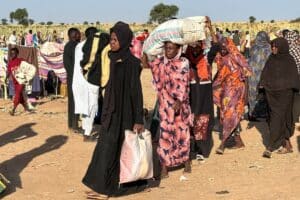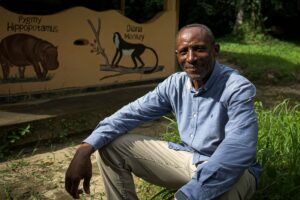January 2024
Dakar, Senegal
On the long beach of Hann Bay in Dakar, a lone man with a shovel and wheelbarrow tirelessly picks up mounds of garbage in such quantities that the task takes on a mythological air.
The smell is pestilential. A few meters away, a pipe carries a black mixture of household and factory wastewater into the Atlantic.
Once considered one of the most beautiful coves in Africa, the former idyllic stretch of fine sand some twenty kilometers long adjacent to the port of Dakar has become the waste dumping ground for an accelerating population and ever-expanding industry.
Most of Senegal’s manufacturing industry is located along the bay and discharges its effluent directly into it. Ocean pollution has reached worrying levels.
For over twenty years, the government has been promising to clean it up. A clean-up project launched in 2018 with financial support from the French Development Agency, Invest International, the Chinese Development Bank (CDB) and the European Union is stalling.
The Office national de l’assainissement (ONAS) has just announced the resumption of work suspended for months. Locals have long been begging for change.
“We’ve been told for years that there’s a project, but nothing changes. I don’t believe it anymore”, despairs
Daouda Kane, 45, sitting on the seafront. A few yards away, a woman is pouring the remains of her lunch pot onto the beach, which is teeming with insects.
– “High toxicity” –
“Here, you cast your nets, you bring in garbage,” complains Modou Ndong, a 53-year-old fisherman. “And you get sick,” he asserts, referring to the episodic appearance of pimples on his skin.
In some places, it’s almost impossible to see the sand beneath the garbage. At regular intervals of a few hundred meters, sewage pipes flow into the sea, blood-red at the slaughterhouse, black for the discharges from the chemical industries and the Senta tannery. The throat burns anyone who gets close.
Researcher Amidou Sonko, who works for the Institut de recherche pour le développement (IRD), has demonstrated the “high toxicity” of the area.
His analyses show concentrations of Escherichia Coli (E. Coli) bacteria 13 to 100 times higher than the authorized limit, and the presence of salmonella. He also observed quantities of enterococci, microplastics, aluminum, chromium and zinc well in excess of standards.
These are all threats to human skin, lungs and eyes, but also to biodiversity, he says. The development of certain species is affected in this natural breeding ground for fish.
Yet Seyni Badiane, a young father, swims with his two- and five-year-old daughters some 30 meters from a canal that discharges green water. “This is the only beach in the neighborhood, so we come here,” he says. “We’re Africans, so we’re used to it,” he adds.
Industrial inertia
“No one can stop children from bathing here,” laments Mbacké Seck, who has been campaigning for depollution for over 25 years.
“We don’t understand the delay. The need is there, the money is there. The negative impact is there in our daily lives. What’s stopping this project from going ahead?” he asks.
The French group Suez is currently building a wastewater treatment plant on the coast, designed to treat 26,000 cubic meters per day for 500,000 inhabitants. AFD, one of the main backers of the project, assures us that it should come on stream in early 2025.
But the rest of the work has been suspended for over a year and a half due to the bankruptcy of the company in charge of laying the main pipe linking the port area to the treatment plant, says Alassane Dieng, project coordinator at ONAS.
“The big difficulty is convincing the industries to participate”, says Mr. Dieng, as they occupy 63% of the urban area according to a 2018 impact study.
They will be connected to the network on condition that they install pre-treatment units, and will pay an industrial fee. If they don’t comply with the rules, a “very dissuasive” pollution tax is planned, much higher than the one in force today, he says. Alassane Dieng promises that the entire project, with a total cost of around 95 billion CFA francs (145 million euros), will be completed by the end of 2025.
By Adrien Marotte –
Humaniterre with AFP





